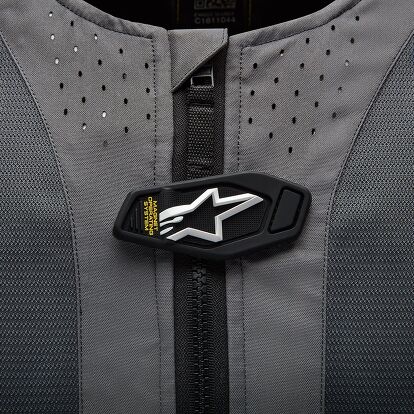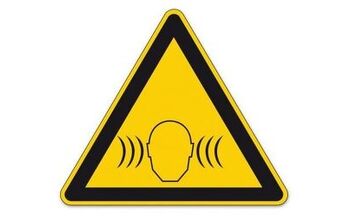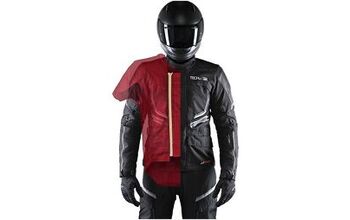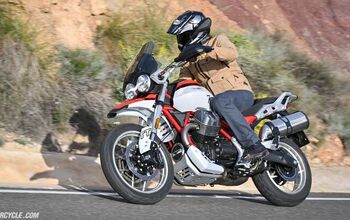Crash Tested: Alpinestars Tech-Air 5 Airbag System

What it's like to actually crash with an airbag
Writing a Crash Tested review is never something we want to do, but if I’m going to write one, then this one is especially important. If you weren’t aware, a couple months ago while comparing the Triumph Speed Twin and BMW R nineT, I was hit by a car. I flew over the hood of the car, did a flip in the air, landed on my shoulder, and rolled to a stop. It sucked, but thankfully I was able to walk away, injury-free albeit pretty sore.
Shop for the Alpinestars Tech-Air 5 here
I credit my safety gear, of course, for protecting me, but there’s one particular item that stands out as the MVP in this case: the Alpinestars Tech-Air 5 airbag vest. Other than a helmet, this is a piece of safety gear I simply won’t ride without anymore.
If you’re familiar with racing, then you’ve likely heard about airbag systems. Multiple companies are making them, and they all have slightly different philosophies on what kind of protection they offer, but the end goal is the same: Upper body protection to reduce, or in some cases eliminate, the most common injuries that occur in a motorcycle crash. You can get a basic understanding of airbags here.
A Bit of History
In the case of the Alpinestars Tech-Air 5, this is a completely independent vest you can wear under any riding jacket, leather or textile, from any manufacturer, as long as there is 4cm (about 1.5 inches) of space around the chest for the airbag to inflate. Like all of the Tech-Air systems, there are no tethers or hard connections between you or the motorcycle. Sensors and a computer enclosed within monitor your riding activity and in the case of a crash – whether it’s a self-inflicted lowside, or in my case, getting hit by a vehicle – it goes off.
Alpinestars has been developing the Tech-Air system for two decades (and is continually developing the technology still) to understand the dynamics of riding a motorcycle on the human body, including what happens during a loss of control (this is an important distinction in terminology compared to just saying “crash” because you can lose control of the motorcycle all by yourself and have an injury. Crashing may imply another object was involved.) This research led to the original Tech-Air system that was primarily used on MotoGP riders, though a commercially available suit entered the market briefly. These early systems integrated the airbag within the suit.
All of the research was used to understand what forces act on the body both under normal riding conditions (including racing) and during a loss of control, both self-inflicted and during an impact. Then the task was to determine what sorts of scenarios warrant an airbag deployment and what scenarios don’t. For example, in many cases a slow-speed, mild lowside won’t trigger the system to deploy – I know because I’ve done it. But it also has to recognize false positives like your buddies tripping you while you’re walking to the bathroom. It doesn’t always work out as planned, though, as evidenced by the times the airbag has gone off while GP riders celebrate their finishes.
Today the Tech-Air family has evolved into a trio of systems – Tech-Air Race, Tech-Air Street, and Tech-Air 5 – and consist of vests that can be worn independent of the jacket or suit. In the case of the TA Race and TA Street systems, fasteners and connectors embedded within the vest require them to be paired with approved suits or jackets. The beauty of the Tech-Air 5 is its ability to be worn independent of the jacket, as well.
How It Works
Of course, the next logical question is how does it work? As you can see, you have a vest. Its external layer is a thin, soft mesh-like fabric, and trapped underneath it is the actual airbag itself. You put it on like you would any other vest and this gives you an idea of the coverage area. It wraps around your midsection, including your ribs, and also covers the shoulders and collarbones, down midway to the rider’s biceps. It fastens via a zippered connection with a magnetic clasp at the bottom to help keep it closed during inflation. On top, there’s a secondary magnetic Velcro strap that activates the system and the three LEDs on the bottom of the vest that show the status of the system.
On the back of the vest is a back protector with a hump at the top about the size of a large sandwich bag. This houses all the electronics and the helium-argon canisters that fire to deploy the airbag. Among those electronics are a total of six sensors – three gyroscopes and three accelerometers – all monitoring the forces acting upon your body. Simply put, once the sensors detect a loss of control, the ECU commands the canisters to fire, deploying the airbag in 20-40 milliseconds, depending on the size of the airbag (it’s available in a range of sizes from Small to 4XL). That’s 10 times faster than the blink of an eye, and important because the airbag needs to be fully inflated to protect the rider before they ever make contact with anything hard or immobile. Like a car. Or the ground.
Riding With It
So, what is it like to ride with the Tech-Air 5? Just like with any new piece of kit, there’s a small learning curve to adjust to. Like, charging it beforehand. This takes some getting used to, but really, it’s like charging any of the other things we now plug in as part of our daily lives. There’s a micro-USB port you plug into (a charge cord is included), and from a completely drained battery, a full top-off takes about four hours. The LEDs will go from blinking to solid to indicate this. A fully-charged battery will get you about 30 hours of riding time, too. Personally, I don’t typically ride for 30 hours straight. So, I’ve never drained a battery dry. Typically, I’ll just charge it after a ride or the night before.
As far as fit goes, there’s a reason Alpinestars recommends four centimeters of space, and it’s not just to allow for the airbag to inflate. Wearing the Tech-Air 5 is like wearing a thick back protector under your jacket (because you are). There’s no getting around the fact it’s an additional layer you’re putting on and there’s a little extra bulk there to account for. Some of my tighter-fitting, race-cut jackets simply don’t work with the TA5 because the vest is too thick. That said, when worn with an appropriate jacket, I quickly forget I’m wearing an additional layer.
The other concern with an additional layer is the amount of airflow it allows, and this is dependent on the jacket you’re pairing it with in the first place. Clearly, a non-vented jacket won’t allow much air in any way. So, pairing it with the TA5 might be a good idea on cooler rides. Since the Tech-Air 5 outer material is mesh, and the included back protector is a honeycomb design, when paired with a high-flow ventilated jacket you’ll still feel some airflow. But there’s no hiding the fact you’re wearing another layer, and thus, not getting the same amount of air as before. Personally, this only bothered me on really hot days, and as I’ve said before – I’d rather sweat than bleed.
While some people bemoan technology, for those interested, the Tech-Air 5 also pairs with Alpinestars’ Tech-Air app. Here you can see the battery status, map your ride, see both max and average speeds, and even download over-the-air updates for your vest’s firmware whenever it becomes available. Unlike other airbags, the TA5 doesn’t track things like lean angle.
Crashing With It
This is one of those things you hope you never have to experience, but since you’re curious, here’s what it was like for me. I have a distinct memory while mid-flight of my chest suddenly feeling pressure, as if someone were giving me a hug. Then it dawned on me – That’s my airbag deploying! No sooner could I finish that thought before I made impact with the ground. In fact, thanks to the internal memory of the system, I know exactly how much time elapsed between the airbag deploying, me having that thought, and my subsequent introduction to the asphalt: 50 milliseconds. In fact, the entire episode, from coming in contact with the car to me coming to a stop only took 1.5 seconds. But as anyone who has crashed before can tell you, these things always feel like an eternity.
Here’s the important takeaway. Thankfully I got hit by a little Porsche and not a huge SUV, and the angle of the impact meant I flew over the hood and not straight into the side of the car. Nonetheless, when I landed, the data from the sensors recorded an impact of over 18g. But I walked away without a broken bone in my body. I’m not so sure I could say the same were I not wearing the airbag.
After the initial realization of my airbag deploying everything else blurred into the background as adrenaline took over and I was focused on coming to a stop. All this is to say I didn’t even notice the airbag throughout the rest of the tumble, especially not at the point the 18g impact occurred.
Aftermath
The Tech-Air 5 is a one-and-done system. Kinda. Unlike the Tech-Air Race airbag system, which gives you two deployments, the Tech-Air 5 only has one discharge. Then you send it back to Alpinestars’ HQ, where for $299, they will inspect, repack, recharge, and bring the system back to full operating status again and send it back to you. Since we’re on the topic of price, the Tech-Air 5 will set you back $699.95, which is significantly less than a hospital visit, especially if you’re taken there in the back of an ambulance or helicopter.
As of this writing, the Tech-Air 5 is currently available in sizes Small – 4XL, with XS coming soon. The vests are supposed to be unisex, though some women I’ve spoken to that have tried other airbags, including other Tech-Air airbags, have not been convinced. Included in the photo gallery below is a size chart (which you can also find at the Alpinestars website) you can use to reference which size is best for you. As I’ve said before, I won’t ride a motorcycle without wearing an airbag now. Like a helmet, these two pieces of equipment are just too vital not to ride without. And while I’m clearly fond of the Tech-Air 5 for saving my bacon when I got punted, I can’t encourage you enough to wear an airbag when you ride, regardless of who makes it.
#gallery-2 {margin: auto;}#gallery-2 .gallery-item {float: left;margin-top: 10px;text-align: center;width: 33%; }#gallery-2 img {border: 2px solid #cfcfcf;}#gallery-2 .gallery-caption {margin-left: 0;}We are committed to finding, researching, and recommending the best products. We earn commissions from purchases you make using the retail links in our product reviews and other articles. Learn more about how this works.
Become a Motorcycle.com insider. Get the latest motorcycle news first by subscribing to our newsletter here.

Troy's been riding motorcycles and writing about them since 2006, getting his start at Rider Magazine. From there, he moved to Sport Rider Magazine before finally landing at Motorcycle.com in 2011. A lifelong gearhead who didn't fully immerse himself in motorcycles until his teenage years, Troy's interests have always been in technology, performance, and going fast. Naturally, racing was the perfect avenue to combine all three. Troy has been racing nearly as long as he's been riding and has competed at the AMA national level. He's also won multiple club races throughout the country, culminating in a Utah Sport Bike Association championship in 2011. He has been invited as a guest instructor for the Yamaha Champions Riding School, and when he's not out riding, he's either wrenching on bikes or watching MotoGP.
More by Troy Siahaan





















































Comments
Join the conversation
You said "I was hit by a car. I flew over the hood of the car, did a flip in the air, landed on my shoulder , and rolled to a stop"
Some airbags, such as In&Motion, do not protect the shoulder (which they say is useless for road use)...
Do you think that a standard CE level 2 protective shell would have protected the shoulder as well? After all, 18g isn't that much.
Thank for this review.
I recall riding my BMW R90S, and hitting a Nissan sedan that pulled in front of me. I flipped over the hood of the car and landed on my feet. Stunned but vertical, I thought how lucky can I be? When I got home, however, I went to soak in a hot bath, and when I stripped off my clothes, I realized my left testicle was purple. Not exactly something you want to see! --James Miller, jim@Millers-ink.com